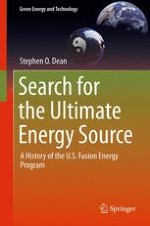2013 | Buch
Über dieses Buch
Why has the clean, limitless energy promised by fusion always seemed just out of reach?
Search for the Ultimate Energy Source: A History of the U.S. Fusion Energy Program, explains the fundamentals and concepts behind fusion power, and traces the development of fusion historically by decade—covering its history as dictated by US government policies, its major successes, and its prognosis for the future. The reader will gain an understanding of how the development of fusion has been shaped by changing government priorities as well as other hurdles currently facing realization of fusion power.
Advance Praise for Search for the Ultimate Energy Source:
“Dr. Dean has been uniquely involved in world fusion research for decades and, in this book, describes the complicated realities like few others possibly could.”
-Robert L. Hirsch, a former director of the US fusion program, an Assistant Administrator of the US Energy Research and Development Administration (ERDA); an executive at Exxon, Arco, and the Electric Power Research Institute (EPRI); and lead author of the book The Impending World Energy Mess (Apogee Prime Books, 2009).
“In this book, Dr. Dean provides the many reasons why fusion has progressed more slowly than many had hoped. Budget is usually cited as the culprit, but policy is equally to blame. Facilities have been closed down before their jobs were done—or in some cases, even started. It seems this situation has become endemic in fusion, and if one thinks about it, in other nationally important Science and Technology initiatives as well.”
-William R. Ellis, a former scientist at Los Alamos National Laboratory, Associate Director of Research at the US Naval Research Laboratory, a vice president at Ebasco Services and at Raytheon, and chair of the US ITER Industry Council and the US ITER Industrial Consortium.
Anzeige
